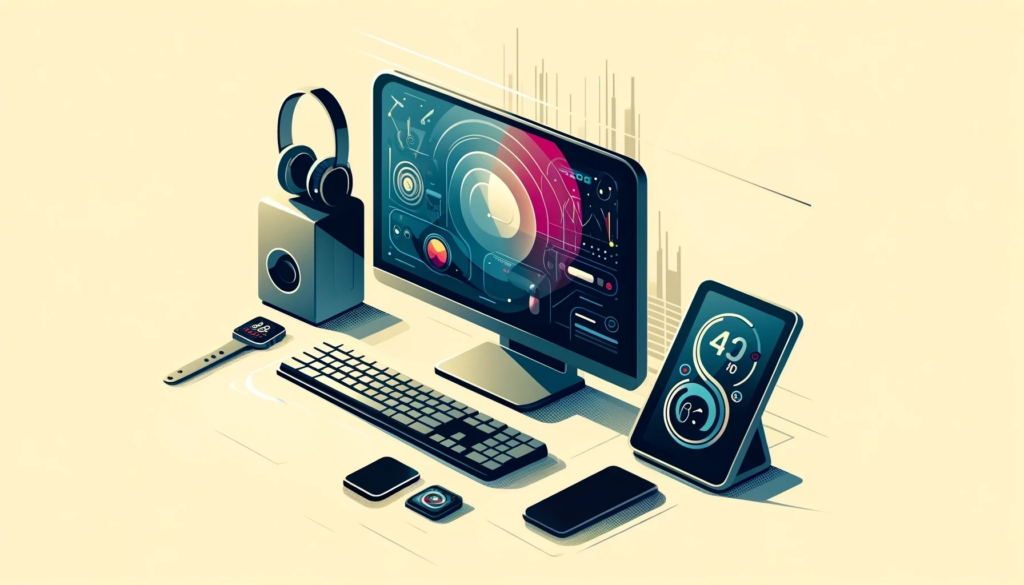Technology in Everyday Life

Technology has woven itself into the fabric of everyday life, becoming an indispensable part. Smartphones, once a luxury, are now seen as essential, helping us communicate, work, and stay informed. With the touch of a screen, we access limitless information, engage in social networks, or shop online with ease. We rely on these devices not only for our social needs but also for managing our daily tasks.
Home automation systems have revolutionized the way we interact with our living spaces. Lights, thermostats, and even locks can be controlled remotely, offering both convenience and improved security. This integration of smart technology into homes saves energy and reduces utility bills, by adapting usage to our habits. In the kitchen, smart appliances assist us in cooking, sometimes even suggesting recipes based on the ingredients we have.
Even our health has been impacted by the advent of wearable technology. Fitness trackers monitor our physical activity, compelling us to stay active and healthy. These devices also track our sleep patterns, giving insights for better rest and overall well-being. The use of telemedicine has grown, allowing patients to consult doctors via video calls. This innovation is particularly valuable for those who live far from medical facilities or have mobility issues.
Transportation has been transformed by technology, from navigation systems that guide us to our destination to ride-sharing apps that make getting around more accessible. The integration of electric and autonomous vehicles on the road illustrates a shift towards more sustainable and safer driving. Public transit has seen improvements too, with real-time updates on arrivals and departures available on our phones.
The workplace, of course, has not been left untouched. Many of us now enjoy the ability to work remotely, courtesy of the internet and cloud computing. Video conferencing tools and collaborative platforms enable effective communication and teamwork, irrespective of distance. These tech advancements have reshaped the traditional office, offering flexibility that was previously unimaginable.
Despite these benefits, it is critical to acknowledge the challenges posed by technology. The digital divide highlights inequality in access to these essential tools. Privacy concerns are rising, with personal data becoming more coveted by corporations and hackers alike. It is our responsibility to balance the convenience of technology with its ethical and social implications. To navigate the digital age successfully, we must foster digital literacy and ensure equitable access for all. This is the only way to fully harness the transformative power of technology in enhancing everyday life.
Text Analysis
CEFR Level Card
General Level: B2.4
Vocabulary: C1.0
Verb Forms: B1.1
Sentences: B1.5
Wordlist
advent NOUN C2 x1
Definition (En):
- arrival that has been awaited (especially of something momentous)
n. the season including the four Sundays preceding Christmas
automation NOUN C2 x1
Definition (En):
- the act of implementing the control of equipment with advanced technology; usually involving electronic hardware
n. the condition of being automatically operated or controlled
n. equipment used to achieve automatic control or operation
autonomous ADJ C2 x1
Definition (En):
- (of political bodies) not controlled by outside forces
s. existing as an independent entity
s. (of persons) free from external control and constraint in e.g. action and judgment
coveted ADJ +∞ x1
Definition (En):
- greatly desired
equitable ADJ C2 x1
Definition (En):
- fair to all parties as dictated by reason and conscience
indispensable ADJ C2 x1
Definition (En):
- not to be dispensed with; essential
s. unavoidable
informed ADJ +∞ x1
Definition (En):
- having much knowledge or education
real-time ADJ +∞ x1
Definition (En):
- of or relating to computer systems that update information at the same rate they receive information
reshape VERB +∞ x1
Definition (En):
- shape anew or differently
v. shape again or shape differently
tech NOUN C2 x1
Definition (En):
n a school teaching mechanical and industrial arts and the applied sciences
thermostat NOUN C2 x1
Definition (En):
- a regulator for automatically regulating temperature by starting or stopping the supply of heat
v. control the temperature with a thermostat
transformative ADJ +∞ x1
Definition (En):
- Having power, or a tendency, to transform.
unimaginable ADJ C2 x1
Definition (En):
s totally unlikely
wearable ADJ +∞ x1
Definition (En):
- suitable for wear or able to be worn
Phrases and Idioms
PHRASE | COUNT | SENTENCES |
access to (someone or something) | 1 |
|
adapt (something) to (something) | 1 |
|
base on | 1 |
|
cloud computing | 1 |
|
courtesy of (someone or something) | 1 |
|
engage in | 1 |
|
interact with (someone or something) | 1 |
|
irrespective of | 1 |
|
touch of something | 1 |
|
with ease | 1 |
|
Reading Comprehension Exercises
True / False / Not Given
- Smartphones are considered an optional accessory for most people today.
- Home automation offers greater convenience by facilitating remote control of household features.
- Smart appliances in the kitchen are able to automatically order ingredients for users.
- Fitness trackers encourage people to increase their physical activity for better health.
- Video calls with doctors have become less common due to wearable technology.
- Navigation systems have made public transportation more difficult to use.
- The contemporary workplace has been reshaped significantly by technological advancements.
- The existence of the digital divide means that access to important digital tools is equally distributed.
- In the current era, ensuring everyone can use technology equally is not considered important.
- Increased reliance on technology in daily life comes with no potential drawbacks or concerns.
- Smart technology in homes does not contribute to any energy savings.
- Online shopping is a complex process that a majority of today’s smartphones cannot handle.
- The growth of telemedicine has lessened the importance of physical proximity to medical facilities for some patients.
It's Your Turn!
Create your multiple choice questions for this reading lesson just in seconds!
Step 1: Click the button to copy the reading text
Step 2: Go to Exercise Creator
Step 3: Paste the reading text
Select question type (Multiple Choice)
Click “Create” and your questions will be ready in seconds!
Short Answer Questions
- What has caused lights and thermostats in homes to be controlled remotely?
- For what reasons might patients find telemedicine especially beneficial?
- Why are fitness trackers believed to promote health?
- How has the use of smartphones become essential in daily life?
- What aspect of transportation has been influenced by the implementation of technology?
- In what ways has the workplace been changed by technical advancements?
- What are the essential tools that the digital divide is causing inequality in access to?
- What is necessary to successfully navigate the digital age according to the text?
- What does smart technology in homes save?
- Why could autonomous vehicles be considered a positive development in transportation?
Multiple Choice Cloze
Technology has woven itself into the fabric of everyday life, becoming an ___1___. Smartphones, once a luxury, are now seen as ___2___, helping us communicate, work, and stay informed. With the touch of a screen, we ___3___ limitless information, engage in social networks, or shop online with ease. We rely on these devices not only for our social needs but also for ___4___ our daily tasks.
Home automation systems have ___5___ the way we interact with our living spaces. Lights, thermostats, and even locks can be controlled remotely, offering both convenience and ___6___. This integration of smart technology into homes saves energy and reduces utility bills, by adapting usage to our ___7___. In the kitchen, smart appliances assist us in cooking, sometimes even suggesting recipes based on the ingredients we have.
Even our health has been impacted by the advent of wearable technology. Fitness trackers monitor our physical activity, compelling us to stay active and ___8___. These devices also track our sleep patterns, giving insights for better rest and overall well-being. The use of telemedicine has grown, allowing patients to consult doctors via video calls. This innovation is particularly valuable for those who live far from medical facilities or have ___9___ issues.
Transportation has been transformed by technology, from navigation systems that guide us to our destination to ride-sharing apps that make getting around more ___10___. The integration of electric and autonomous vehicles on the road illustrates a shift towards more sustainable and safer driving. Public transit has seen improvements too, with real-time updates on arrivals and departures available on our phones.
The workplace, of course, has not been left untouched. Many of us now enjoy the ability to work remotely, courtesy of the internet and cloud computing. Video conferencing tools and collaborative platforms enable effective communication and teamwork, irrespective of distance. These tech advancements have reshaped the traditional office, offering flexibility that was previously unimaginable.
Despite these benefits, it is critical to acknowledge the challenges posed by technology. The digital divide highlights inequality in access to these essential tools. Privacy concerns are rising, with personal data becoming more coveted by corporations and hackers alike. It is our responsibility to balance the convenience of technology with its ethical and social implications. To navigate the digital age successfully, we must foster digital literacy and ensure equitable access for all. This is the only way to fully harness the transformative power of technology in enhancing everyday life.
1) A. indispensable part B. intermittent component C. occasional element D. temporary part
2) A. essential B. nice to have C. opulent D. redundant
3) A. restrict B. access C. forbid D. block
4) A. monitoring B. managing C. neglecting D. underestimating
5) A. ignored B. revolutionized C. hampered D. maintained
6) A. jeopardy B. challenge C. improved security D. danger
7) A. habits B. mistakes C. guesswork D. exceptions
8) A. healthy B. sedentary C. vulnerable D. passive
9) A. visual B. communication C. mobility D. hearing
10) A. restricted B. accessible C. obsolete D. exclusive
Writing Exercise
Writing Exercise
Q. Write one paragraph about how you use technology every day, including specific examples of how it helps you.
Answer Key
True / False / Not Given Answers
- False
Explanation: The statement contradicts the text which states that smartphones are now seen as essential, not optional.
(“Smartphones, once a luxury, are now seen as essential, helping us communicate, work, and stay informed.”)
- True
Explanation: The text directly supports the statement that home automation allows for greater convenience through remote control capabilities.
(“Lights, thermostats, and even locks can be controlled remotely, offering both convenience and improved security.”)
- Not Given
Explanation: The text does not provide information about smart appliances automatically ordering ingredients for users.
(“N/A”)
- True
Explanation: The statement is true as per the text; it mentions fitness trackers monitor our activity and compel us to stay active and healthy.
(“Fitness trackers monitor our physical activity, compelling us to stay active and healthy.”)
- False
Explanation: The text states that the use of telemedicine, which involves video calls with doctors, has grown, implying an increase rather than a decrease.
(“The use of telemedicine has grown, allowing patients to consult doctors via video calls.”)
- False
Explanation: According to the text, public transit has seen improvements, not difficulties, with the help of technology like navigation systems.
(“Public transit has seen improvements too, with real-time updates on arrivals and departures available on our phones.”)
- True
Explanation: The statement is true as the text mentions that technological advancements have reshaped the traditional office.
(“These tech advancements have reshaped the traditional office, offering flexibility that was previously unimaginable.”)
- False
Explanation: The digital divide actually signifies inequality in access, which is the opposite of equal distribution.
(“The digital divide highlights inequality in access to these essential tools.”)
- False
Explanation: The text states that ensuring equitable access for everyone is necessary to navigate the digital age successfully.
(“To navigate the digital age successfully, we must…ensure equitable access for all.”)
- False
Explanation: The text clearly mentions the need to acknowledge challenges posed by technology, implying there are potential drawbacks.
(“Despite these benefits, it is critical to acknowledge the challenges posed by technology.”)
- False
Explanation: The text indicates that smart technology in homes saves energy, which contradicts the statement.
(“This integration of smart technology into homes saves energy and reduces utility bills, by adapting usage to our habits.”)
- False
Explanation: The text states that online shopping can be done with ease on smartphones, contradicting the statement that it’s a complex process.
(“With the touch of a screen, we access limitless information, engage in social networks, or shop online with ease.”)
- True
Explanation: The statement is supported by the text which indicates telemedicine is valuable for those far from medical facilities, suggesting lessened importance of physical proximity.
(“This innovation is particularly valuable for those who live far from medical facilities or have mobility issues.”)
It's Your Turn!
Create your multiple choice questions for this reading lesson just in seconds!
Step 1: Click the button to copy the reading text
Step 2: Go to Exercise Creator
Step 3: Paste the reading text
Select question type (Multiple Choice)
Click “Create” and your questions will be ready in seconds!
Short Answer Answers
- Home automation systems.
Explanation: The text credits home automation systems for the ability to control lights and thermostats remotely.
(“Home automation systems have revolutionized the way we interact with our living spaces.”)
- Living far from medical facilities or having mobility issues.
Explanation: The text specifies that those living far from medical facilities or with mobility issues would find telemedicine especially valuable.
(“This innovation is particularly valuable for those who live far from medical facilities or have mobility issues.”)
- They compel us to stay active.
Explanation: The text suggests that fitness trackers encourage physical activity, thereby promoting health.
(“Fitness trackers monitor our physical activity, compelling us to stay active and healthy.”)
- For communication, work, and staying informed.
Explanation: The text mentions that smartphones are essential for communication, work, and staying informed.
(“helping us communicate, work, and stay informed.”)
- Navigation systems and ride-sharing.
Explanation: The text indicates that technology has influenced transportation through navigation systems and ride-sharing apps.
(“from navigation systems that guide us to our destination to ride-sharing apps that make getting around more accessible.”)
- Remote work, video conferencing, and collaborative platforms.
Explanation: The text describes changes in the workplace due to remote work capacity, video conferencing, and collaborative platforms.
(“Many of us now enjoy the ability to work remotely, courtesy of the internet and cloud computing. Video conferencing tools and collaborative platforms enable effective communication and teamwork, irrespective of distance.”)
- Technology.
Explanation: The ‘essential tools’ in question are inferred to be technological tools, as discussed in the context of the digital divide.
(“The digital divide highlights inequality in access to these essential tools.”)
- Fostering digital literacy and ensuring equitable access.
Explanation: The text states that digital literacy and equitable access are necessary for successfully navigating the digital age.
(“To navigate the digital age successfully, we must foster digital literacy and ensure equitable access for all.”)
- Energy and reduces utility bills.
Explanation: The text links the integration of smart technology to energy savings and lower utility bills.
(“This integration of smart technology into homes saves energy and reduces utility bills, by adapting usage to our habits.”)
- More sustainable and safer driving.
Explanation: The text points out that the development of autonomous vehicles leads to more sustainable and safe driving practices.
(“The integration of electric and autonomous vehicles on the road illustrates a shift towards more sustainable and safer driving.”)
Multiple Choice Cloze Answers
- A
Explanation: The adjective ‘indispensable’ means absolutely necessary or essential, which is the correct answer.
- A
Explanation: ‘Essential’ indicates that something is absolutely necessary, which fits the context.
- B
Explanation: To ‘access’ information means to obtain or make use of it, which is the correct context.
- B
Explanation: ‘Managing’ is the process of dealing with or controlling things, which fits the context.
- B
Explanation: ‘Revolutionized’ suggests a dramatic and wide-reaching change, which is appropriate here.
- C
Explanation: ‘Improved security’ is the positive outcome of controlling devices remotely.
- A
Explanation: Usage adapting to ‘habits’ indicates the customization and efficiency of smart homes.
- A
Explanation: ‘Healthy’ is related to good health, which is the outcome desired from physical activity.
- C
Explanation: ‘Mobility’ issues affect someone’s ability to move, fitting the context of telemedicine’s value.
- B
Explanation: ‘Accessible’ means easy to obtain or use, which describes the effect of ride-sharing apps on transportation.
Your Own Reading Lesson
Create Your Own Lesson with Cathoven AI
You can create your own reading lesson based on your interests or those of your students!
Go to;
Type the topic you are interested in, select the level and genre you are looking for, and click Generate!
Paste the reading text you generated and get a detailed analysis of your text.
Select the type of exercise, paste the reading text, and click Create!
Your reading lesson is ready!




